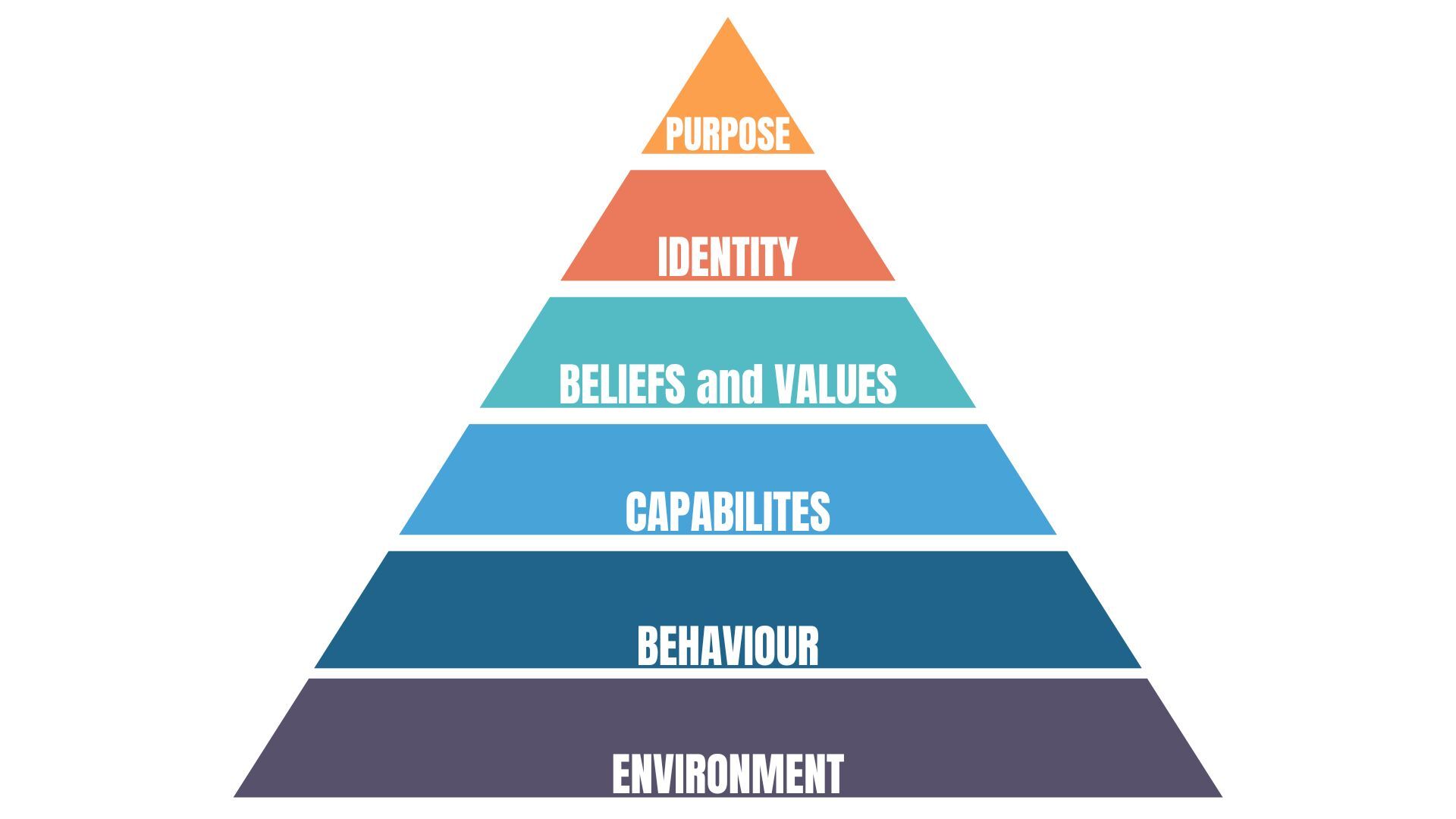3.5: The Logical Levels Model

The Logical Levels model, often attributed to anthropologist Gregory Bateson (1972) and further developed by Robert Dilts (1990), is a framework for understanding how different levels of processes within individuals and systems interact and influence one another. It’s used in coaching and personal development and is especially helpful for understanding career transitions.
The model proposes that learning and change can be categorized into a hierarchy of logical levels. Each level is progressively more influential on one’s behaviour and identity, with changes at the higher levels having a broader impact on the lower levels. The levels are as follows:
- Environment: This level is about the external conditions where a person’s behaviour takes place. It includes the physical space, the people around the person, the time of day, etc.
- Behaviour: The specific actions and reactions that are observable within the environment.
- Capabilities: These are the skills and strategies a person must perform. It includes abilities, knowledge, and experience.
- Beliefs and Values: The personal belief systems and values that provide the framework for making decisions and justify behaviours and capabilities.
- Identity: A person’s sense of self. It’s about how individuals perceive themselves and what they identify with.
- Spirituality or Purpose: Some interpretations include this level, which pertains to the broader system, purpose, or connection to something greater than oneself.
Exhibit 3.1 depicts the various hierarchies of logical levels.

At the base of the Logical Levels model, the Environment level represents the physical and social backdrop where one’s professional life unfolds. Moving up, the Behaviour level refers to the specific actions and roles one engages in at work. The Capabilities level encompasses the skills and knowledge necessary to perform effectively in a chosen career. The Beliefs and Values level reflects the inner convictions and principles that motivate and justify professional choices. The Identity level pertains to one’s professional self-image and role within a career. Finally, the top level, sometimes referred to as Spirituality or Purpose, transcends the individual to consider broader questions of meaning and connection to a larger mission or calling. Changes at higher levels, such as beliefs or identity, can cascade down to inform and transform aspects at the lower levels, like behaviour and environment, making this model a powerful tool for navigating and facilitating career transitions.
Watch this video on the Logical Levels to get a better understanding of this model.
Source:
Helen Oakwater. (2018, May 29) Robert Dilts explains NLP Logical Levels of learning & change. [Video] YouTube. https://youtu.be/hrK9_ZPo790
Practical Application of the Logical Levels Model
For example, if a student wants to improve their study habits (Behaviour), they might first change their study environment by finding a quiet place without distractions (Environment). To enhance their capabilities, they might learn new study techniques or time management skills (Capabilities). This could lead to a change in their beliefs about their ability to study effectively (Beliefs and Values), which ultimately might affect how they see themselves as a student (Identity). If this change is aligned with a larger purpose, such as contributing to the well-being of their community or advancing in their career (Spirituality or Purpose), it reinforces the changes at the lower levels.
An essential aspect of this model is that a change at a higher level will affect all levels below it, but not necessarily the other way around. Therefore, interventions aimed at higher levels are often considered more powerful.
First-hand Experience
Here’s an example of how someone might navigate a career change using the Logical Levels model:
- Environment: Kiran works in a corporate office setting but feels uninspired. Kiran decides to make a career change to something more aligned with their values.
- Behaviour: In their current job, Kiran’s behaviours include routine tasks that they no longer find fulfilling. Kiran has started to explore different industries and jobs that could suit their interest.
- Capabilities: Kiran realizes that to shift careers, they need new skills. Kiran begins to take courses on digital marketing, recognizing this is a key capability needed for the new career they are interested in.
- Beliefs and Values: Kiran must address the belief that they’re only suited for the corporate world. As Kiran gains new skills, their belief shifts to “I am adaptable and can succeed in different fields.” This is bolstered by Kiran’s core values of growth and learning.
- Identity: As Kiran acquires new skills and beliefs, they start to see themselves not just as a corporate employee but as a creative professional. They identify themselves as someone who can thrive in a dynamic, creative career.
- Spirituality or Purpose: Kiran’s decision to change careers is also driven by their desire to do meaningful work that contributes positively to society. Kiran feels that their purpose is not just to earn a living but to make a difference through their work.
As Kiran moves through these levels, the changes at each level reinforce and support the changes at the other levels. For instance, Kiran’s new identity as a creative professional might lead them to behave more confidently in their new role, seek environments that nurture their new career, and further develop their capabilities, all of which are aligned with their core values and a sense of purpose.

